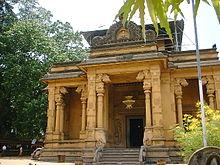Kelaniya Raja Maha Vihara
| Kelaniya Raja Maha Vihara | |
|---|---|
කැලණිය රජ මහා විහාරය | |
 | |
| Religion | |
| Affiliation | Buddhism |
| District | Gampaha |
| Province | Western Province |
| Location | |
| Location | Kelaniya, Sri Lanka |
| Municipality | Kelaniya |
| Geographic coordinates | 06°57′11.3″N 79°55′06.7″E / 6.953139°N 79.918528°E |
| Architecture | |
| Type | Buddhist Temple |
The Kelaniya Raja Maha Vihara or Kelaniya Temple is a Buddhist temple in Kelaniya, Sri Lanka. It is located 11 km (6.8 mi) north-east of Colombo. The current chief incumbent (chief priest) is Venerable Professor Kollupitiye Mahinda Sangharakkhitha Thera.
The temple has often been associated with the rise and fall of Ceylon / Sri Lanka, with the popular saying that as the Kelaniya temple rose, Sri Lanka rose and as it fell, the country and its administration fell. It has thus had a deep association with the political powers of the country.
It is also infamous for Mapitigama Buddharakkitha, the chief conspirator of the 1959 assassination of Ceylon's fourth Prime Minister S. W. R. D. Bandaranaike.[2] Buddharakkitha was the chief incumbent (chief priest) of the Kelaniya Raja Maha Vihara from 1947 to 1959.[3]
History
Buddhists believe the temple to have been hallowed during the third and final visit of the Buddha to Sri Lanka, eight years after gaining enlightenment.[4] Its history would thus go back to before 500 BCE. The Mahawansa records that the original Stupa at Kelaniya enshrined a gem-studded throne on which the Buddha sat and preached. The temple flourished during the Kotte era but much of its land was confiscated during the Portuguese empire. Under the Dutch empire, however, there were new gifts of land and under the patronage of King Kirthi Sri Rajasingha the temple was rebuilt. It was refurbished in the first half of the 20th century with the help of Helena Wijewardana.
The temple is also famous for its image of the reclining Gautama Buddha and paintings by the native artist Solias Mendis which depict important events in the life of the Buddha, in the history of Buddhism in Sri Lanka, also incidents from the Jataka tales. It is the venue for the Duruthu Maha Perehera procession each January. An 18-foot stone statue of the Bodhisattva Avalokitesvara has been erected at the temple.
References
- ^ "Protected Monument List 2012-12-12" (PDF). Department of Archaeology. 12 December 2012. Retrieved 27 March 2016.
- ^ "Parabhawa Sutta Vs. Mapitigama Buddharakkitha". LankaWeb. 2010. Retrieved 5 February 2011.
- ^ "Authoritarianism and the Crisis of Identity". UTHR. Retrieved 5 February 2011.
- ^ Wilhelm Geiger (Tr), The Mahavansa, or The Great Chronicle of Ceylon, Oxford, OUP, 1920. "Archived copy". Archived from the original on 2008-10-30. Retrieved 2009-01-28.
{{cite web}}: CS1 maint: archived copy as title (link)

